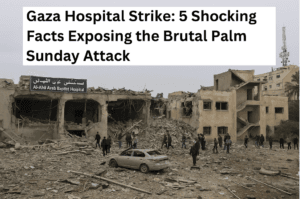Gaza Hospital Strike: 5 Shocking Facts Exposing the Brutal Palm Sunday Attack
Israeli airstrikes struck Gaza on Palm Sunday, intensifying a humanitarian crisis as attacks targeted Al-Ahli Arab Baptist Hospital—a critical medical facility in northern Gaza—damaging its emergency ward, pharmacy, and displacing over 100 patients. The assault, which Israel claimed targeted Hamas infrastructure without providing evidence, killed at least 21 people, including a child who died mid-evacuation.
Simultaneous strikes elsewhere killed six brothers working for a food charity and a family in Jabaliya refugee camp, leaving a pregnant woman injured and homeless. Gaza’s health system, already crippled by six months of war, faces collapse as remaining hospitals struggle without supplies or functional equipment. Over 50,000 Palestinians, mostly women and children, have now been killed since October 2023, with Israel vowing to expand military operations.
The attack on a Christian-affiliated hospital during Holy Week underscored the war’s erosion of Gaza’s interfaith heritage, while regional tensions flared as Yemen’s Houthis launched a missile toward Israel. Civilians, trapped in a cycle of violence, plead for global attention as survival grows dire.

Gaza Hospital Strike: 5 Shocking Facts Exposing the Brutal Palm Sunday Attack
As Christians worldwide observed Palm Sunday, marking the start of Holy Week, Gaza faced one of its most devastating days in a conflict that shows no sign of abating. Israeli airstrikes targeted multiple sites across the enclave, including Al-Ahli Arab Baptist Hospital in Gaza City—a critical healthcare facility already grappling with the toll of six months of war. The attack, which Israel claims targeted a Hamas command center (without publicly presenting evidence), left the hospital’s emergency room, pharmacy, and adjacent buildings in ruins, killing at least 21 people and forcing the evacuation of over 100 patients.
A Sacred Space Shattered
The strike on Al-Ahli Hospital, operated by the Episcopal Diocese of Jerusalem, drew sharp condemnation for its timing during a period of profound religious significance. “This is a direct attack on a place of healing and worship,” read a statement from the Diocese, underscoring the hospital’s role as one of northern Gaza’s last functioning medical centers. Dr. Fadel Naim, the hospital’s director, described chaotic scenes as staff struggled to relocate patients outdoors amid the rubble. One young girl died during the evacuation when overwhelmed medics couldn’t provide urgent care.
The attack is the fifth on Al-Ahli since the war began, according to Medical Aid for Palestinians, raising urgent questions about Israel’s adherence to international laws protecting medical facilities. While Israel maintains Hamas uses hospitals as shields, humanitarian groups stress that such strikes disproportionately harm civilians, including women and children, who make up the majority of Gaza’s over 50,000 reported fatalities.
Beyond the Hospital: A Pattern of Devastation
Sunday’s violence extended far beyond Al-Ahli. In Deir al-Balah, a strike on a car killed six brothers—aged 10 to 25—who worked distributing food aid. Their father, Ibrahim Abu Mahadi, wept as he asked, “For what sin were they killed?” Hours later, another attack leveled a home in Jabaliya refugee camp, killing seven, including a mother and her husband, while a pregnant woman, Alaa Manoun, was pulled from the rubble with a broken ankle, only to learn her youngest daughter had died.
These incidents underscore a grim reality: even in areas Israel previously declared “safe,” such as Khan Younis, renewed bombardments have shattered any semblance of security. Meanwhile, Gaza’s healthcare system teeters on collapse. With Al-Ahli’s CT scanner buried under debris, doctors now lack the means to assess injuries like internal bleeding or fractures, leaving patients like Manoun in limbo.
Conflicting Narratives and Regional Ripples
Israel’s military asserts its strikes precision-target Hamas infrastructure, citing over 90 militant sites hit in 48 hours. Yet survivors and local witnesses repeatedly describe attacks on densely populated civilian areas. “There’s no resistance here—only civilians,” insisted Abdallah Dardouna, a neighbor to the Jabaliya strike.
The conflict’s regional ramifications also flared as Yemen’s Houthi rebels launched a missile toward Israel, signaling solidarity with Gaza. While intercepted, the act highlights how the war fuels broader Middle Eastern tensions, with Iran-backed groups escalating involvement.
The Human Cost of a Protracted War
Since Hamas’ October 2023 attack killed 1,200 Israelis and sparked the war, Gaza’s civilians have borne the brunt of retaliatory campaigns. Over 1.7 million are displaced, and aid groups warn of famine amid Israel’s blockade. With ceasefire talks stalled and 24 hostages still held captive, prospects for de-escalation remain dim.
Why This Matters
The Palm Sunday strikes exemplify a cycle of violence where civilian spaces—hospitals, homes, aid networks—are increasingly battlegrounds. For Gaza’s tiny Christian community, the attack during Holy Week adds a layer of symbolic devastation, eroding centuries of coexistence in a land they’ve called home for generations. As the world’s attention wavers, the urgency for accountability, humanitarian access, and a path to peace grows ever more critical.
You must be logged in to post a comment.